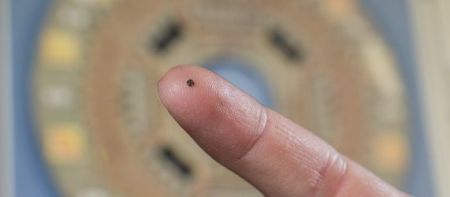A team of researchers has developed the technology for a catheter-based device that would be able to provide real time, 3-D imaging from inside a persons’ heart, coronary arteries and peripheral blood vessels.
This innovate device could offer better guidance during heart surgery and enable more clearing of clogged arteries to be done without the necessity of major surgery.
Integrating ultrasound transducers with electronics on a single 1.4 millimeter silicon chip, this on-chip processing of signals facilitates data transmission from more than a hundred elements on the device via only 13 tiny cables, allowing it to easily travel through circuitous blood vessels. These forward-looking, device-generated images would provide considerably more information than existing cross-sectional ultrasound.
During testing this prototype was capable of providing image data at 60 frames per second, and as a next step, researchers plan to conduct animal studies that could lead to commercialisation of the device.
F. Levent Degertekin, a professor in the George W. Woodruff School of Mechanical Engineering at the Georgia Institute of Technology explained that this device would allow doctors to see the whole volume in front of them within a blood vessel, giving cardiologists the equivalent of a flashlight to visualise blockages in occluded arteries ahead of them. With most of the devices being used for this today providing only cross-sectional images, this invention has the potential for reducing the amount of surgery required to clear these vessels.
Details of the research, which was supported by the National Institute of Biomedical Imaging and Bioengineering (NIBIB), part of the National Institutes of Health, were published online in the February 2014 issue of the journal IEEE Transactions on Ultrasonics, Ferroelectrics and Frequency Control.
The single chip device combines capacitive micromachined ultrasonic transducer (CMUT) arrays with front-end CMOS electronics technology to provide three-dimensional intravascular ultrasound (IVUS) and intracardiac echography (ICE) images. The dual-ring array includes 56 ultrasound transmit elements and 48 receive elements. When assembled, the donut-shaped array is just 1.5 millimeters in diameter, with a 430-micron center hole to accommodate a guide wire.
Power-saving circuitry in the array reduces the amount of heat generated inside the body, with the ultrasound transducers operating at a frequency of 20 megahertz (MHz). By miniaturising transmission elements and carrying out some of the processing on the probe itself, the team of researchers was able to obtain what they believe are clinically-useful images with only 13 cables.
As Degertekin pointed out, integrating the electronics and the imaging array on the same chip allowed for the most compact and flexible catheter possible.
Based on their prototype, the researchers hope to conduct animal trials to demonstrate the device's potential applications. Following this, they ultimately expect to license the technology, conduct the clinical trials required in order to receive FDA approval.
As his next project, Degertekin envisages the development of a device version capable of guiding interventions in the heart under magnetic resonance imaging (MRI). Other plans include further reducing the size of the device to place it on a 400-micron diameter guide wire.
Story and image source: Science Daily
20 February 2014
Latest Articles
Imaging, Ultrasound, Heart, Cardiac, Technology, Visualisation, catheter, 3D imaging, blood vessels, coronary, artery, Active MRI, microchip
A team of researchers has developed the technology for a catheter-based device that would be able to provide real time, 3-D imaging from inside a persons�...



























